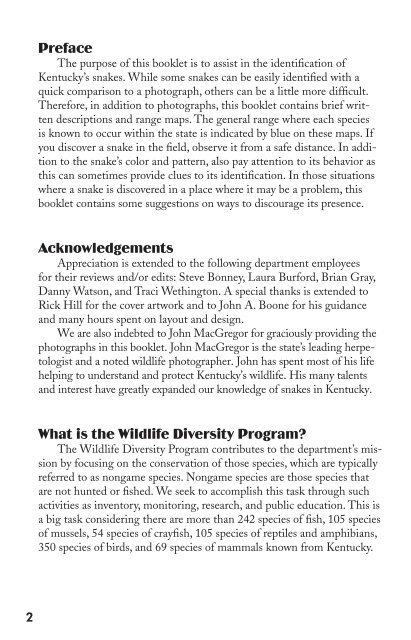Kentucky Snakes
kysnakebook
kysnakebook
- No tags were found...
Create successful ePaper yourself
Turn your PDF publications into a flip-book with our unique Google optimized e-Paper software.
PrefaceThe purpose of this booklet is to assist in the identification of<strong>Kentucky</strong>’s snakes. While some snakes can be easily identified with aquick comparison to a photograph, others can be a little more difficult.Therefore, in addition to photographs, this booklet contains brief writtendescriptions and range maps. The general range where each speciesis known to occur within the state is indicated by blue on these maps. Ifyou discover a snake in the field, observe it from a safe distance. In additionto the snake’s color and pattern, also pay attention to its behavior asthis can sometimes provide clues to its identification. In those situationswhere a snake is discovered in a place where it may be a problem, thisbooklet contains some suggestions on ways to discourage its presence.AcknowledgementsAppreciation is extended to the following department employeesfor their reviews and/or edits: Steve Bonney, Laura Burford, Brian Gray,Danny Watson, and Traci Wethington. A special thanks is extended toRick Hill for the cover artwork and to John A. Boone for his guidanceand many hours spent on layout and design.We are also indebted to John MacGregor for graciously providing thephotographs in this booklet. John MacGregor is the state’s leading herpetologistand a noted wildlife photographer. John has spent most of his lifehelping to understand and protect <strong>Kentucky</strong>’s wildlife. His many talentsand interest have greatly expanded our knowledge of snakes in <strong>Kentucky</strong>.What is the Wildlife Diversity Program?The Wildlife Diversity Program contributes to the department’s missionby focusing on the conservation of those species, which are typicallyreferred to as nongame species. Nongame species are those species thatare not hunted or fished. We seek to accomplish this task through suchactivities as inventory, monitoring, research, and public education. This isa big task considering there are more than 242 species of fish, 105 speciesof mussels, 54 species of crayfish, 105 species of reptiles and amphibians,350 species of birds, and 69 species of mammals known from <strong>Kentucky</strong>.2


